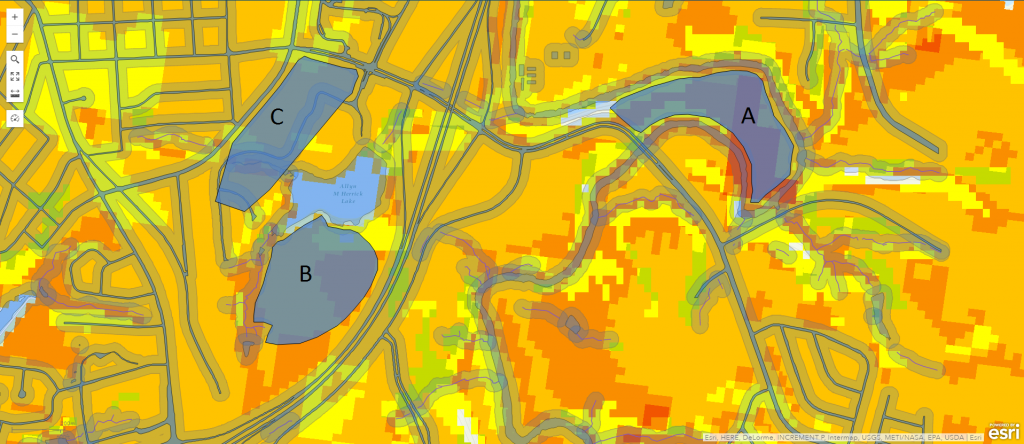Site Suitability
Using Geoplanner, I took common data such as road and bodies of water locations and overlaid them onto a map with three pre-selected sites. Buffers were then created for the common data to narrow down the areas in which a snail farm might be placed based on how much they overlapped.
In the end, all three selected sites were at least moderately suitable for a snail farm, but some were slightly better than others. The closer to red a cell is, the more suitable it is for a snail farm. Therefore, taking into account the approximate ratios of each colour in the site areas, I determined that A had the most suitable area, B had moderate suitability, and C was still suitable but not the best choice.
 Weighted Overlay
Weighted Overlay
The above briefly describes which of the three sites is most promising for a snail farm and how the sites were bounded using buffers. However, in order to actually analyse the most suitable space, and therefore produce the coloured cells, I ran a weighted overlay analysis that took into account five specific factors. I weighted each factor, shown in the table to the left, according to how important I believed it was in ensuring that a site was suitable for a snail farm.
 Each factor tab could then be expanded to adjust individual weights of the overall factor, allowing me to more narrowly define the importance of that factor. The example to the right shows the expansion of the Aspect factor tab, where I assigned high values of importance to all north facing aspects and moderate values of importance to all other directions.
Each factor tab could then be expanded to adjust individual weights of the overall factor, allowing me to more narrowly define the importance of that factor. The example to the right shows the expansion of the Aspect factor tab, where I assigned high values of importance to all north facing aspects and moderate values of importance to all other directions.
I went into each factor tab and adjusted all of the individual settings so that they were customised to what I believed was important when considering where to build a snail farm. After completing this, I then assigned overall weights to the five factors and ran the analysis, generating the map above.
Aspect
Aspect refers to the direction in which a site is facing. Since snails do not thrive in sunny environments, I assigned the highest suitability numbers to those directions that faced primarily north, as indicated in the table above. I then assigned every other direction a medium suitability value. Overall, however, I chose not to give Aspect a high weight in the total weighted overlay, because although sun is an important factor, artificial methods can be employed to shade an area and therefore make it more suitable for a snail farm.
Agricultural Soils
Agricultural Soils play a key role in the selection of a site, as I do not want to construct a snail farm in an area that is highly suitable for growing crops. However, agricultural soils can also be highly suitable for the farming of snails, so that was taken into account. Fully ‘developed’ agricultural sites were restricted. Despite the importance of this factor, I chose to weight it at a lower value than other categories because its importance pales in comparison to the two main factors: Human Modified and Slope.
Human Modified
Human Modified refers to the percentage of development. I weighted this the highest, along with Slope, because existing development plays a crucial role in where a snail farm can and should be located. I did not want to place a snail farm in an area that was already highly developed because that would limit the size of the farm and also potentially create a situation in which the snails could be endangered by theft, predators/vehicles, or vandalism.
Land Cover
Land cover is important in that it determines where a snail will thrive- obviously a snail is not going to do well on, say, a polar ice cap or in a body of water. Therefore, completely unsuitable categories were restricted to ensure they were not taken into account, while areas such as barren land, open grassland, and forest were considered more important because they provide natural conditions for snails even without an artificial farm. Therefore, Land Cover is given the second highest weight value because it indicates areas that will not need as much intervention to create a snail farm. Land cover was still weighted less than Human Modified and Slope, however, because it is much easier to artificially recreate a land cover type within a farm than it is to undevelop an area or drastically modify its topography.
Slope
Finally, Slope was assigned a high weighted percentage because of the impact it has on building, maintaining, and traversing a snail farm. Slope, like land cover, can be remodeled through artificial means, but in this case I chose to restrict any extreme slopes and make lower slopes weighted highly. Although the slope of an area can be changed through grading, building a snail farm on a site that requires little to no grading is both ecologically and financially responsible.
